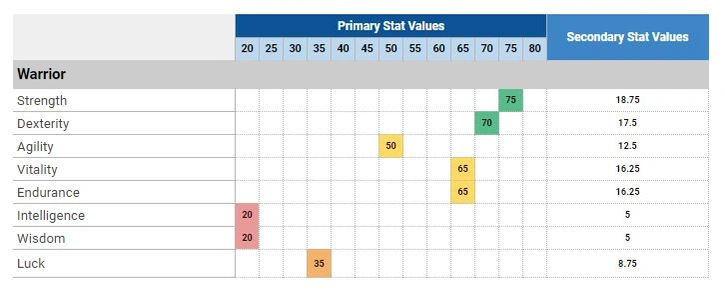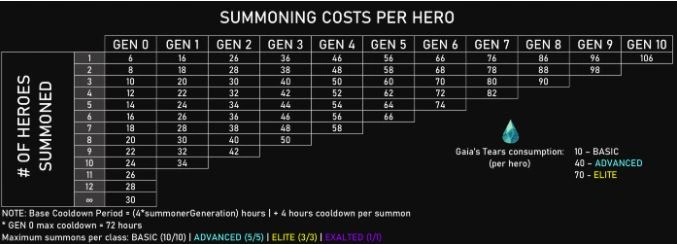How To Choose a DeFi Kingdoms Hero

DeFi Kingdoms is not only a popular gamified decentralized exchange (DEX), but it has also gained popularity in the play-to-earn (P2E) sector of the cryptocurrency and NFT world. If you're reading this, you're likely aware of Axie Infinity, the most well-known play-to-earn NFT game. Similar to Axie, DeFi Kingdoms not only gives users opportunity to earn $JEWEL, the native in-game token, but also valuable in-game items through their Hero NFTs. These Hero NFTs are the backbone of the DeFi Kingdoms game and there are an overwhelming number of factors to consider when purchasing one.
DeFi Kingdom Heroes each hold lots of individual information displayed on the cards (see below) which can be used to help evaluate Hero performance and value relative to others. Below we'll take a look at the front and back of the card and discuss all of the factors to be considered when spending precious $JEWEL on these P2E assets. New to DeFi Kingdoms? Refer to our guide on all the basics!
Evaluating a DeFi Kingdom Hero From the Front of the Card
The DeFi Kingdom Hero class structure currently has 15 classes in four different tiers:
Basic |
Advanced |
Elite |
Exalted |
|
Knight Warrior Thief Archer Monk Pirate Wizard Priest |
Paladin DarkKnight Ninja Summoner |
Dragoon Sage |
DreadKnight |
The biggest impact classes have on game mechanics is how a Hero progresses each time it is leveled up. When a Hero gets to the required experience point (XP) threshold and is leveled up, each stat on the back of the card has a fixed probability of increasing by one. In a nutshell, the game does a “roll” for each stat based on the primary and secondary class growth rates, giving a binary outcome of yes or no for that given stat to level up. Each class varies in what stats it is more likely to increase – we’ll talk about why stats are important for profession questing and future player-versus-player and player-versus-environment (PvP, PvE) mechanics below.
Generally speaking, each subsequent class tier from above will have a higher cumulative stat growth than its predecessor, making the advanced/elite/exalted classes more desirable. DFK Community member Freya has created a guide to see the stat growth rates of each class, let’s look at an example:
In this example we can see when leveling up a Warrior it has a 75 percent chance of increasing its Strength, 70 percent chance of increasing its Dexterity, and so on. After rolling for each Primary Stat the game will move on to another set of “rolls” based on the secondary class. Building up these stats will have an immediate impact on Hero performance during profession questing, but also a long-term impact on how it may perform in a PvP or PvE combat situation.
How Does a DeFi Kingdoms Hero's Stat Growth Rate Impact Professions?
We know stats have an impact on profession, but how? The game has dictated that the performance of a Hero in each profession quest is based upon its level and more importantly, the sum of two stats that have been deemed important for that profession. Those stat combinations per profession are included in the table below.
Mining |
Gardening |
Foraging |
Fishing |
|
STR+END |
WIS+VIT |
DEX+INT |
LCK+AGI |
If we connect the dots we know each class grows certain stats at a higher rate than others and that each profession has specific stats that are important to it. By taking the primary stat growths we can deduce that these classes are generally “best” at a specific profession. When using the class and stat growth information we can start to determine which Hero is the best to buy. DeFi Kingdoms community member Albus has created a chart that shows us the optimal classes for each profession type:
What Are The DeFi Kingdoms Hero Rarities?
Heroes will fall into one of five rarity tiers: Common, Uncommon, Rare, Legendary, and Mythic. When looking in the tavern, the DeFi Kingdoms marketplace, you’ll notice the market places a higher value on each rarity tier as you progress from Common to Mythic. There are two significant impacts on rarity as it relates to game mechanics and Hero value – stat bonuses and summoning probabilities.
Hero Stat Bonuses
We’ve already discussed stat growth rates at a baseline level, but there is another stat growth mechanic that comes in to play every five levels that is entirely based upon rarity. When a Hero reaches level 5, 10, 15, and so on, it will not only receive its base stat growths (one roll for each stat based on primary class, one roll for each stat based on secondary class), but will receive a certain number of bonus stat growths relative to its rarity tier. Here’s the explainer that can be found in the DeFi Kingdoms documentation:
Uncommon
- +1 to two random, mutually exclusive stats
Rare
- +1 to three random, mutually exclusive stats
- +1 to a random stat (including any that received a bonus already)
Legendary
- +1 to three random, mutually exclusive stats
- +1 to two random, mutually exclusive stats (including any that received a bonus already)
- +2 to a random stat (including any that received a bonus already)
Mythic
- +2 to three random, mutually exclusive stats
- +1 to three random, mutually exclusive stats (including any that received a bonus already)
- +1 to a random stat (including any that received a bonus already)
The bonus mechanic can be overwhelming to read and comprehend to a first time Hero buyer so here’s a summary – the rarer the hero, the more bonuses you get every level 5 levels. The more bonuses a Hero receives, the better your Hero will be at profession questing and eventual PvP and PvE games.
Hero Summoning Outcomes
The DeFi Kingdoms Hero summoning could be five thousand word guide on its own so let’s keep it simple – when a player uses two Heroes to create a new one (summoning), the resulting Hero’s rarity tier is based upon the two parents. The rarer the parents, the higher probability the child has of being Rare, Legendary, or Mythic. The chart below lays out the probabilities of summoned (child) Hero’s rarity tier:
Generation and Summons
The last important factor on the front of the DeFi Kingdoms Hero card is the Hero’s generation and summons remaining. Generation primarily impacts how expensive it is to summon with a Hero. Each time a user summons there is a fee paid in $JEWEL. This fee is calculated based on generation and number of summons already performed with the respective Hero. In the chart below we can see that each subsequent generation is significantly more expensive to summon with:
“But Gump, I don’t plan on summoning, do I even need to worry about generation and summons remaining?”
The short answer is yes. Even if you don’t plan to summon with your Heroes the market places a premium on Heroes with low generation, high summons remaining. Choosing a Hero that meets the criteria is not only great for optionality, but also maintaining resale value in the event you wanted to sell your Hero in the Tavern.
Other Front of Card Factors
There are several other factors on the front of the card that are important, but we don’t yet know what impact they have on game mechanics.
- Element & Background – doesn’t currently play a role in the game, but will in the future.
- Gender – no importance as of now, any two heroes can summon a new one regardless of their gender.
- Level – use this as a tiebreaker when shopping, but all heroes can be leveled up by questing.
- HP & MP – these will play a role in combat mechanics for PvP/PvE, they grow as a Hero levels up.
What Does the Back of the DeFi Kingdom Hero Card Show?
The back of each Hero card is more straightforward and is easier to understand after reading about stat growth rates, professions etc. There are two important distinctions on the back of each Hero card – Blue/Green/Purple stat genes and the Profession gene.
What Are the DeFi Kingdom Hero Stat Genes?
On the back of each hero card you’ll find certain stats are highlighted in blue, green, or even purple. When a hero is created the game selects stat(s) to be boosted in one of two ways.
Blue gene – this stat receives a +2% increase to the primary stat growth success rate and a +4% increase to the secondary stat growth success rate. It may seem like an insignificant boost, but over time will make a measurable impact on how the blue stat progresses. The market places a small premium on blue stats that are aligned to a hero’s profession and class.
Green gene – when the hero was created the green stat received a +2 point boost. The green stat gene is a one-time modifier and has no impact after the hero is created. There is no measurable premium on a green gene that aligns with a class and/or profession.
Purple gene – on rare occasions a hero may receive both the blue and green gene on the same stat. This is indicated in purple text.
Profession Gene & Skill
While a Hero can perform any profession, the game grants a profession gene upon creation to indicate the profession it is “best” at – highlighted in green. Heroes that go on quests aligned to their profession are able to complete them in less time than their non-green counterparts, meaning you can quest more often to receive rewards (in-game items, $JEWEL rewards, etc). Putting the pieces together that we’ve already learned we can optimize selecting a hero by factoring in class, stat growth rates, stat specialization, and the profession gene.
How To Shop For a DeFi Kingdoms Hero Example
Based on all the above information we can gather, if you wanted to search for a mining Hero, this is the information that we could use to help make that decision.
- Mining quests value high Strength and Endurance.
- Knights and Warriors have high stat growth percentages for STR+END.
- We can expect even higher stat growth rates if STR or END is highlighted in blue or purple.
- The mining profession being highlighted in green means we can complete mining quests faster.
With this information categorized, we can understand that the optimal miner in this scenario would be a Knight or Warrior with the Mining profession gene (in green).
In a perfect world the Hero would also have STR or END in blue/purple, but that may most often be used as a tiebreaker and not a premium.
Buying a Hero for the first time can be overwhelming because of the number of factors that can be taken into account. Take your time and remember all Heroes are useful. Heroes can be resold in the Tavern at any time, so no mistake is permanent. Keep this guide handy and after a few weeks you’ll be a Hero buying expert.
Disclaimer: Lucky Trader is not a registered investment advisor. You understand that the service is furnished for your personal noncommercial, information, purpose only. No mention of an NFT in the service constitutes as a recommendation to buy, sell, or hold that or any other NFT. Nothing within the service shall, or is intended to, constitute financial, legal, accounting, or tax advice. Any decision that you make to buy, sell, or hold an NFT should be based on an assessment of your risks in consultation with your personal advisers.





